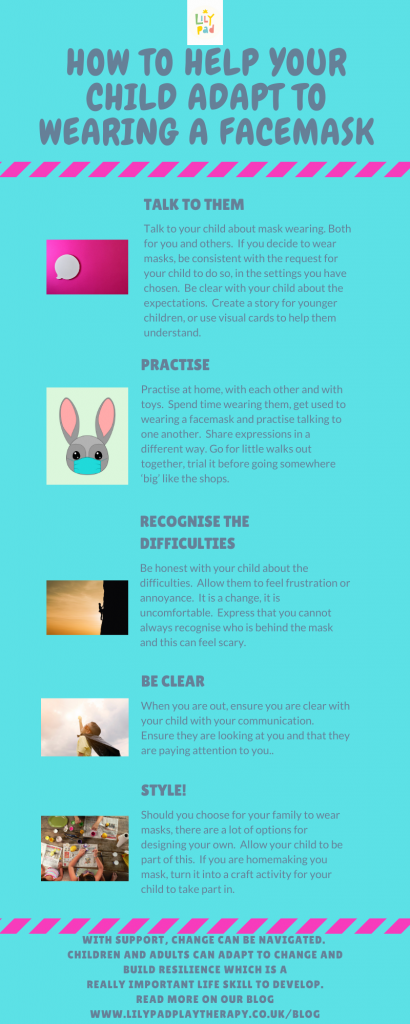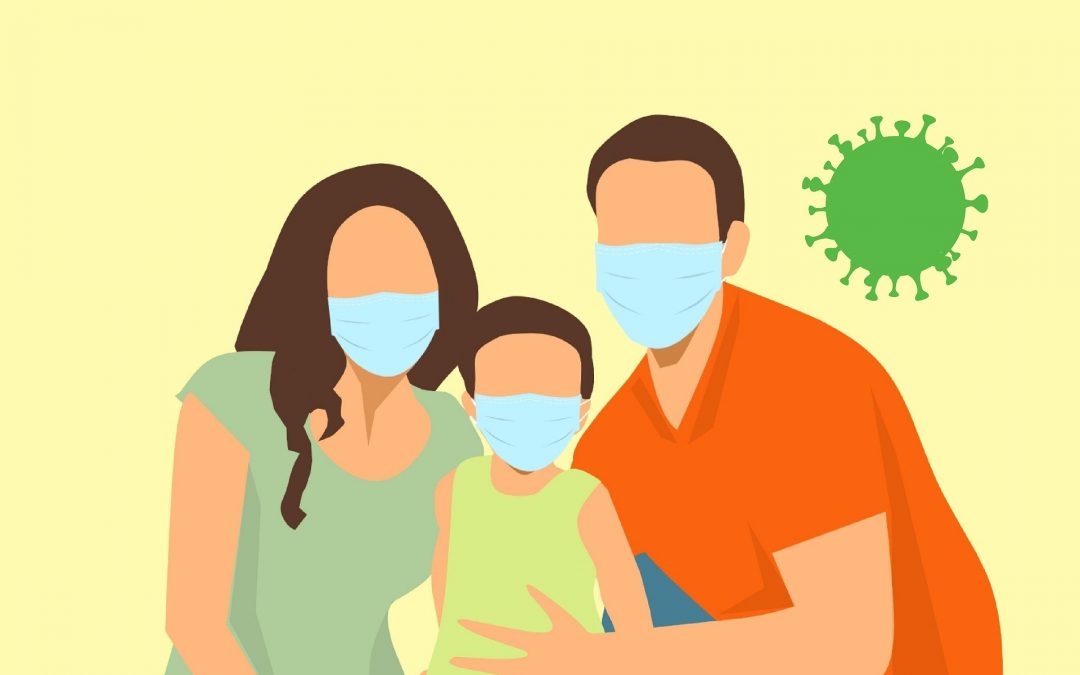As the Covid-19 tsunami turns to waves and the world starts to open for business again, life is starting to look very different from that which we knew only a few months ago. Advice in relation to what protective measures to take will vary. Should advice be given to wear a facemask, what impact could this have on your child? Here we look at some of the potential effects and what you can do to support your child.
Will wearing a facemask impact my child? Even if one makes the choice not to wear a mask, both wearing and seeing others in masks is likely to have an impact on us all in the first instance. It is important to keep in mind how facemasks take away a very important part of communication, the mouth. Whilst verbal communication will not be affected, expressions will not be able to be read; and for children this is likely to be particularly hard to comprehend.
As we become used to this way of living, if it is indeed a medium to long term measure, it is likely that it will become more ‘normal’ and adults and children will adapt. Children have a reduced ability to read emotions and so it is likely that they will be impacted to a greater extent than adults. Here we look at why this is and some of the things you can do to support your child.
*this article is not to be taken as advice in relation to whether or not you should wear a facemask. Please consult PHE or WHO for the latest advice and guidance

The importance of recognising change
Firstly, we have to recognise the huge impact of the Covid-19 pandemic on us all. At the time of writing there are 13 countries out of 193 in the World who are yet to record a case (that’s less than 7% of the world) (Source: Koryo Tours) and even those countries with no cases recorded have been impacted as many of them are currently in ‘lockdown’. Change has been inevitable and moving forward it remains a big feature of our lives. The change to mask wearing, as many have already chosen to do, is but one of many changes we and our children will need to weather.
Change brings with it unpredictably and uncertainty. It is this that impacts thoughts, feelings and behaviours. When something is new, we do not have previous experiences to rely upon to help guide us with how to think, feel and behave. Previous experiences teach us possible outcomes to scenarios; we have no blueprint for a pandemic. This can lead to us seeking security, consistency and safety in things we can control (remember the toilet roll stockpiling?!). Recognising these feelings in both ourselves and our children helps us navigate these changes more readily.
Adapting to change helps build resilience, a really helpful skill in navigating life. The difficulty with the change to wearing masks in public is that this will (hopefully) be a temporary measure, which makes the change even more uncertain. Do not underestimate the impact of this change on both you and your children.
The importance of the mouth
The mouth is an important part of communication. We use it to smile, frown and even bare our teeth (think Vinnie Jones). It helps others understand what it is we are conveying to them. Whilst we rely on other aspects of communication such as tone of voice, body language and contextual cues to understand others, take the mouth out of the equation and we can find it hard to read people.
Several studies confirm that as children get older they become more accurate in reading facial cues from others (Source: Frontiers for Young Minds). The phase ‘smize’ refers to smiling with the eyes and whilst one may try to perfect this, other emotions are likely to be far harder to convey with just our eyes.
The mouth and eyes together are ‘two major expressive sources’ (Source: Research Gate). The eyes are often described as the ‘window to the soul’ however their role as an insight into one’s feelings is impacted upon by the mouth (Source: Research Gate). Without the mouth there is a lesser degree of accuracy in identifying emotions; particularly emotions that are not ‘happy’. This is likely to be more complex for children to comprehend due to their emotional immaturity and under-developed empathy.

Expressions and the face
In time, it may be facemask wearing will become more of a ‘norm’. In some cultures, facemask wearing is already a day-to-day occurrence. Furthermore, the wearing of the Niqāb and Burka in the Muslim faith can be seen the world over. As the norm in some countries, the lack of visible facial expression is managed in communication and naturally reliance is placed on the other aspects of interaction. Although the use of ‘reading’ facial expressions will be hindered by facemask wearing, we also use other forms of communication such as tone of voice and body language to communicate and so it is likely that we will become more reliant on these forms of interaction.
Clowns, robots, the ‘Scream’ mask and zombies all have a fear factor to varying degrees for most people. In common they all have faces devoid of emotion. Automatonophobia is a fear of figures designed to represent humans and Maskaphobia is the fear of masks. The reason for these fears is unknown, but it is thought that it is linked to our expectations of human behaviour (Source: Very Well Mind). With the wearing of facemasks as a precaution in the Covid-19 pandemic, these masks will allow some facial expression to be seen and so we will not be devoid of all visual input from the face.
*It is important to note that one can have a fear of something without it being a phobia; a phobia should be appropriately diagnosed by a professional.
How can I help my child?
Talk to them – Just like staying home, mask wearing is a measure to help others. Talk to your child about this. Talk to them about the choice you have made to wear masks and how this is to keep them and other’s safe and prevent the spread of Coronavirus. If you decide to wear masks, be consistent with the request for your child to do so, in the settings you have chosen. Some may chose not to wear them where the is not a requirement, but if you have chosen to wear them at the shops but not at a friend’s house (as and when this is allowed) be clear with your child about the expectations. You might want to create a story for younger children, or use visual cards to help them understand.

Practise – Practise at home. Practise with toys. Put them on and off each other, spend time wearing them and get yourselves used to wearing a facemask. Practise talking to one another, share expressions in a different way. You may also want to play a game of ‘Guess the Expression’, each choosing a different feeling and expressing this whilst wearing the mask. Go for little walks out together, trial it before going somewhere ‘big’ like the shops.
Recognise the difficulties – Be honest with your child about the difficulties there may be or difficulties they express. Allow them to feel frustration or annoyance if this is what they are expressing, try not to deny them these feelings. It is a change, it is uncomfortable. Express that you cannot always recognise who is behind the mask and this can feel scary. Be honest about the change.
Be clear – When you are out, ensure you are clear with your child with your communication. Ensure they are looking at you and that they are paying attention to you.
Style! – Should you choose for your family to wear masks, there are a lot of options for designing your own. Allow your child to be part of this; allow them to choose the design they want where possible. If you are homemaking you mask, turn it into a craft activity for your child to take part in.

Whilst it is likely that there will be some impact on your child in relation to communication which may add to anxieties linked to Coronavirus, with support, change can be navigated. Children and adults can adapt to change and build resilience which is a really important life skill to develop.


Recent Comments